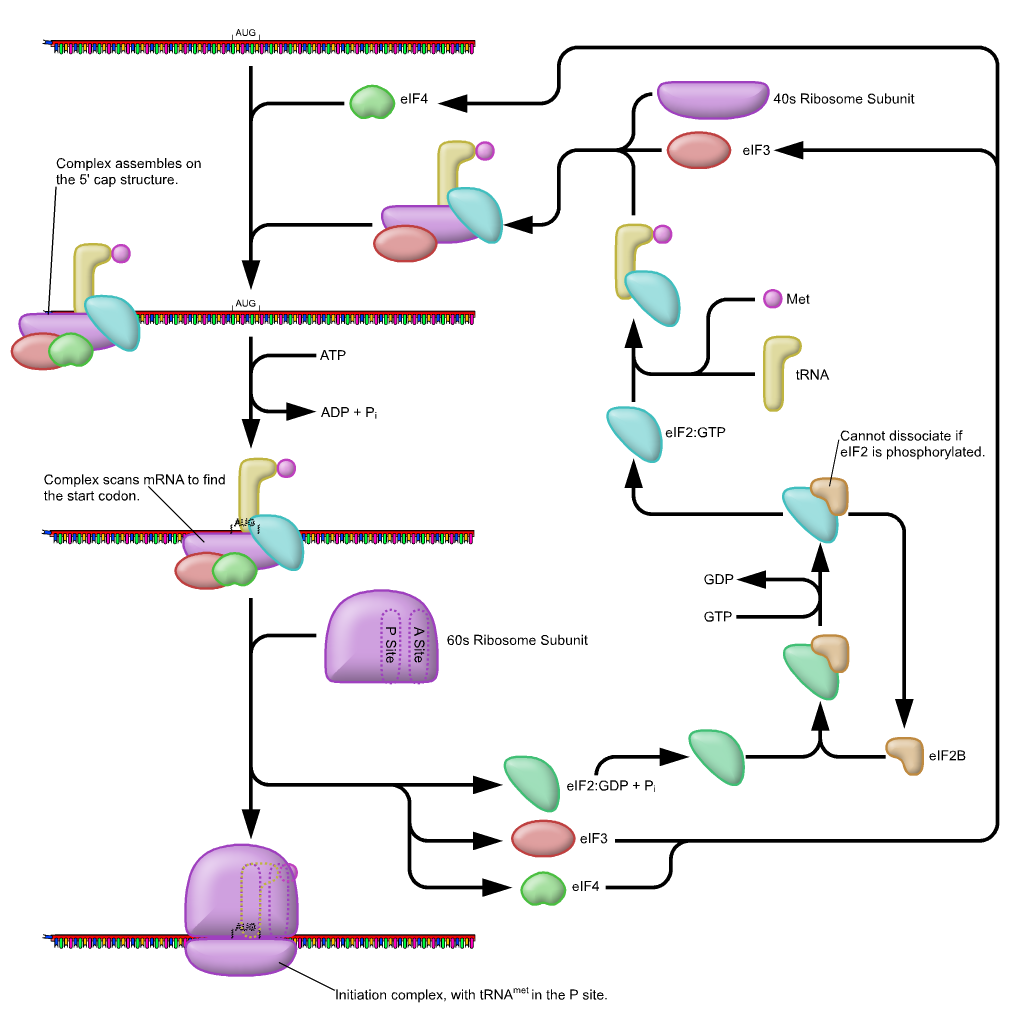Daily Newsletter March 29, 2012
Today's Topic: Translation
The core concept of translation is the connecting of a codon to an amino acid. As we saw yesterday, this is accomplished with the Transfer RNAs. What that leaves us with then is the actual mechanism of amino acid polymerization.
Initiation of Transcription
Protein function is determined by the sequence of amino acids. This sequence allows the protein to fold into the correct configuration to produce activity. Any variation in the sequence could produce alterations to function, or even result in non-functionality. In order to generate the correct sequence, we must first establish the correct reading frame of codons. We must first find the start codon on mRNA.
The small subunit of the Ribosome (40s in eukaryotes) is built to find the Start Codon (AUG) and will align the full ribosome with the correct reading frame. A number of proteins will help the alignment, and in the formation of the full (holozyme) Ribosome.
Elongation
The polymerization of amino acids occurs during elongation. This is where the P and A sites become important (NOTE: P and A sites are the active sites of the enzyme). P stands for Peptidyl, while A stands for Aminoacyl. These are chemical terms, and discuss the orientation of the amino acid. The exit site, represented by E, is not an active site. Consider it a disposal point for spent tRNAs.
During elongation, when you have a filled P and A site, the amino acid from the P site will be linked to the amino acid in the A site. Refer to the following illustration:
The amino end of the amino acid is free. The carboxyl end is attached to the tRNA. Starting at the top, the growing amino acid chain is attached to a tRNA in the P site. A new tRNA with an aminom acid (charged tRNA) is brought into the A site. Using GTP, the Ribosome (large subunit) takes the growing peptide chain and links (carboxyl to amino) it to the individual amino acid in the A site. When this is done, the entire ribosome shifts downstream to the next codon (the new codon appears in the A site).
The spent tRNA that started in the P site is now moved to the E site, where it is removed from the ribosome. NOTE: It takes 2 GTP to create the peptide bond, then another GTP to move the ribosome. So a total of 3 GTP are used in one 'round' of Ribosomal action. REMEMBER THIS!
This process of adding amino acids will continue until a STOP codon is reached.
Statement: To charge a tRNA, you must use an ATP to first phosphorylate the amino acid.
Question: How much ATP will you need to expend to make a protein with 100 amino acids? How about a 150 amino acid protein?
Termination
To create a functional protein, translation must end with the appropriate amino acid. If translation stops to soon, the protein will be to short and many not bend (configure) correctly. If it is too long, then it may not bend (configure) correctly. Termination is there for an important process.
In eukaryotes, a releasing factor is used to seperate the ribosomal subunits.
Once completed, proteins can be further modifed as fits their function (such as adding sugars).
Daily Challenge:
IN YOUR OWN WORDS describe the process of translation. Discuss initiation, elongation and termination. Make sure that you discuss the P and A site, as well as the importance of the start and stop codon. Afterwards, give a BRIEF discussion of the importance of proteomics to modern research.



No comments:
Post a Comment